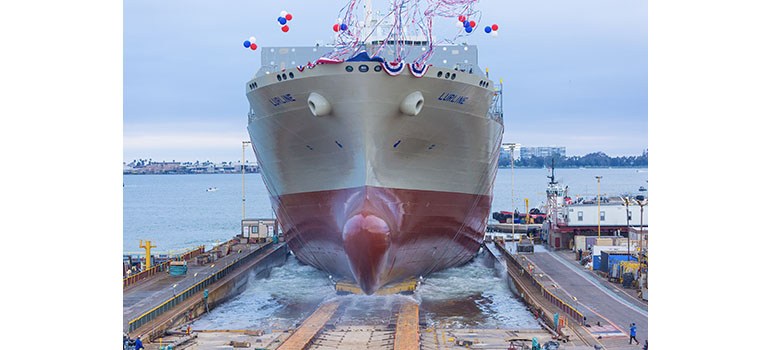As we celebrate Independence Day, it is well worth noting that the American Maritime Partnership (AMP) and federal lawmakers recently announced that California is the fourth largest domestic maritime state in the United States.

Lurline, recently christened in San Diego, is the largest container/roll-on, roll-off ship ever built in the United States. Photo courtesy of Matson
BY PATRICK BURNSON
Published: July, 2019
As we celebrate Independence Day, it is well worth noting that the American Maritime Partnership (AMP) and federal lawmakers recently announced that California is the fourth largest domestic maritime state in the United States.
According to the findings of a new report conducted by Pricewaterhouse-Coopers on behalf of Transportation Institute, the Jones Act fuels a strong domestic maritime industry in the Golden State. The industry employs more than 51,450 individuals, produces $12.21 billion for the local economy and generates $3.6 billion in worker income in California alone.
Furthermore, this is an important shipyard state. A recent study of shipbuilding by the U.S. Maritime Administration, covering both commercial and military ship construction, found a $3.67 billion annual economic impact in California with 34,810 associated jobs and more than $2.38 billion in worker income.
The Jones Act is not only a vital anchor for economic strength and job creation in California, but also a pillar of the nation’s security and military capability. Among other things, the law states that the transportation of merchandise between U.S. ports is reserved for U.S.-built, -owned and -documented vessels.
The Jones Act study findings were announced last month in San Diego at the christening of Lurline, the newest combination container/roll-on, roll-off (“con-ro”) ship of Oakland-based Matson and General Dynamics NASSCO shipyard. Lurline is the largest con-ro ship ever built in the United States.
“As a proud U.S. company and Jones Act carrier, our investment in this new ship is about much more than maintaining a high level of service to Hawaii,” said Matson’s chairman, Matt Cox. “It also helps drive substantial economic benefits and opportunities in communities around the Pacific, where this vessel will operate.”
Cox also shared some insights regarding working waterfront imperatives. “These are all living wage jobs, supporting the families of American workers, the taxes they pay and the local impact they make all flow from this one ship,” he said. “Multiply that by all the ships NASSCO and other U.S. shipyards are building, and you get a sense of the value of the maritime industry to our country and its economy.”
Container Volumes Surge at Port of Oakland
Bigger ships are challenging the Port of Oakland with never-seen-before container volumes. According to port spokespeople, the vessels typically load and unload the equivalent of 1,767 20-foot boxes (TEUs) each time they call. It’s the highest container move count in port history, up almost 10 percent from 2018 and 50 percent over 2009.
The port said higher move counts result from shipping lines consolidating more cargo on larger vessels. It added that bigger loads test the port’s cargo-handling capacity but that cargo continues to move briskly.
“Ships still depart within 24 hours of arrival and harbor truckers are usually getting in and out with their container loads in less than 80 minutes,” said Port of Oakland Maritime Director John Driscoll. “It’s a tribute to the marine terminal operators who’ve stepped up to meet our cargo demand.”
The port said Oakland terminals—where vessels load and unload—keep big ships on schedule thanks to high productivity. The best example: Oakland ship-to-shore cranes can move as many as 30 to 40 containers per hour. That’s the highest productivity level on the West Coast, the port added.
Higher vessel move counts are no surprise. That’s because Oakland set a record in 2018 by handling the equivalent of 2.55 million TEUs. Volume is up another 5.5 percent so far this year. But the impact of all-time high volume is being magnified by greater ship size, the port said.
The port explained that as bigger ships discharge more containers than in previous years, cargo handling intensifies. A greater number of exports must be loaded to vessels while simultaneously, more imports are taken off. Meanwhile, harbor truckers are arriving in greater number to haul containers to final destinations.
Big ships load and unload as many as 2,500 containers on Oakland visits. That’s less than some ports where move counts can surpass 10,000 boxes per vessel. It’s nevertheless an unprecedented challenge.
Earlier in this decade, ships carrying 4,000 to 8,000 cargo containers were standard in Oakland. Today, ships able to handle 10,000 to 14,000 containers are commonplace. “It’s a matter of economics,” said Driscoll. “By loading more cargo on bigger ships, the shipping lines can actually reduce the number of vessels they deploy.”
Oakland vessel calls have declined 9.3 percent this year despite record volume. That’s good for two reasons: there’s less crowding at vessel berths and ship emissions are down.
Mike Zampa, the port’s communications director, said dockside labor has responded well as volume continues to increase. “High labor productivity has become an Oakland hallmark,” he added.
Patrick Burnson is the executive editor of Logistics Management. www.logisticsmgmt.com

